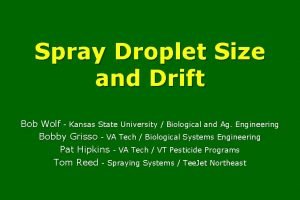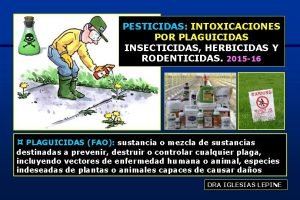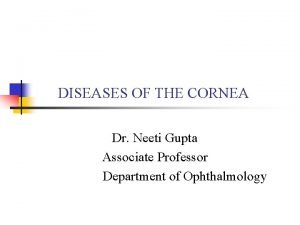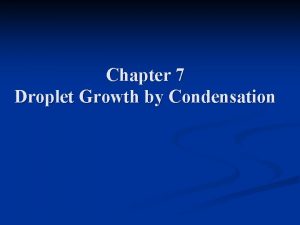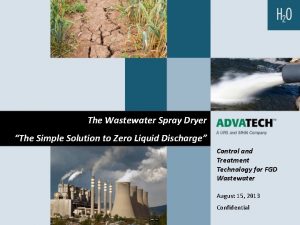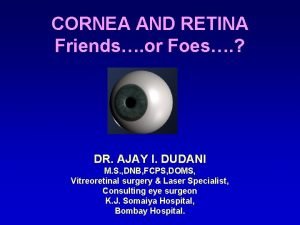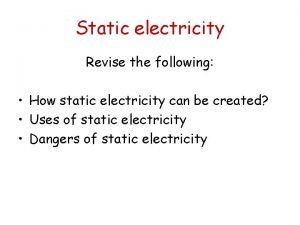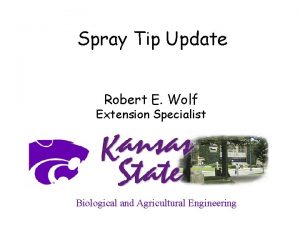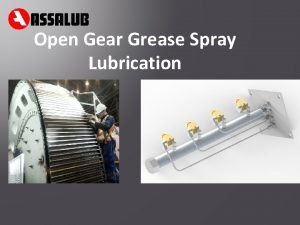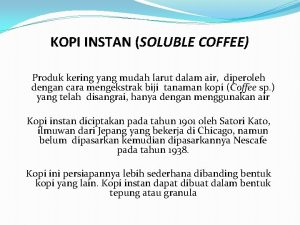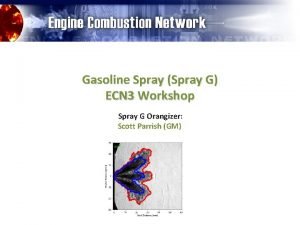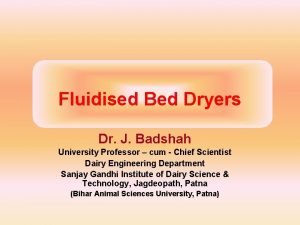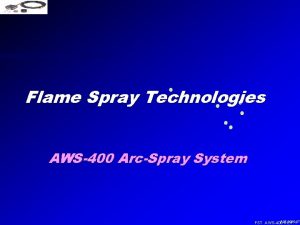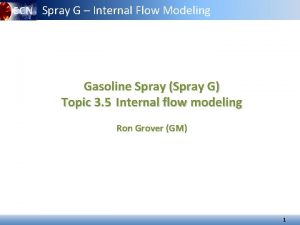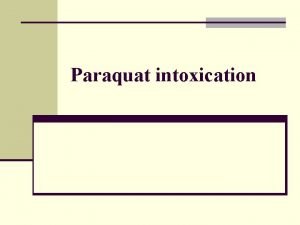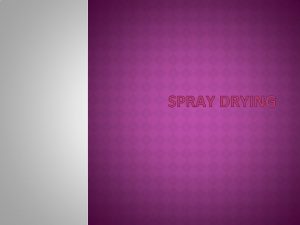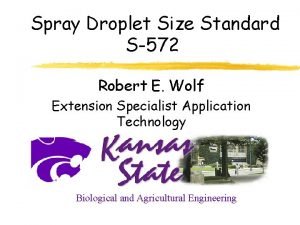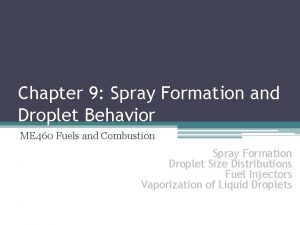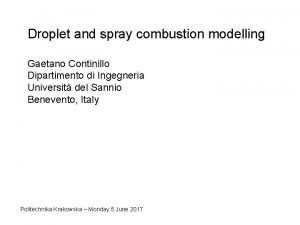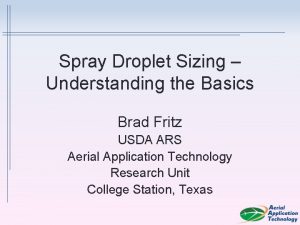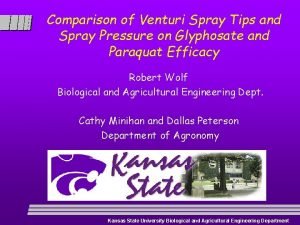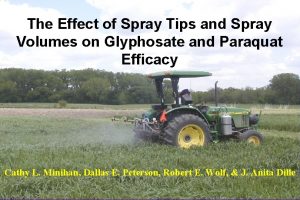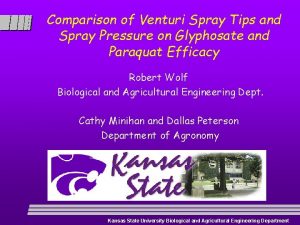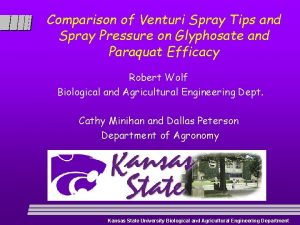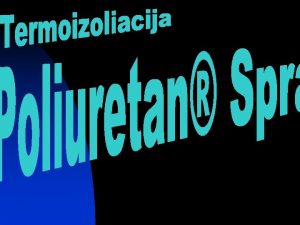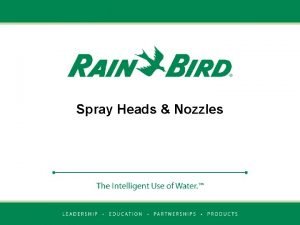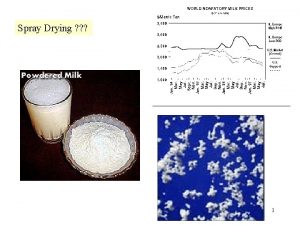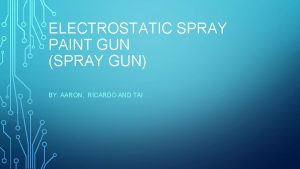Influence of Spray Droplet Size on Paraquat and


























- Slides: 26

Influence of Spray Droplet Size on Paraquat and Glyphosate Efficacy Robert Wolf Biological and Agricultural Engineering Dept. Cathy Minihan and Dallas Peterson Department of Agronomy Kansas State University Biological and Agricultural Engineering Department

Nozzle is still an important part of the application process! Determines the application rate l Determines the uniformity l Determines the coverage l Determines the drift potential l Kansas State University Biological and Agricultural Engineering Department

Determines coverage: l Need knowledge of the product being used. – Systemic – Contact l What is the target? – Soil or canopy? – Grass or broadleaf (smooth, hairy, waxy)? – Orientation and time of day? Kansas State University Biological and Agricultural Engineering Department

What’s new in nozzle technology? l l Nozzles designed to reduce drift Improved drop size control Kansas State University Biological and Agricultural Engineering Department

XR Flat-fan and Turbo Flat-fan compared to Venturi Style Nozzle 5. 0 MPH wind at 40 psi XR vs Turbo. Drop Turbo Flat vs Turbo Drop Kansas State University Biological and Agricultural Engineering Department

1/2 of spray volume = smaller droplets VMD 1/2 of spray volume = larger droplets Kansas State University Biological and Agricultural Engineering Department

Objective of this study: l Field measure the spray droplet characteristics of a venturi flat-fan nozzle compared to extended range and turbo flat-fan nozzles. Kansas State University Biological and Agricultural Engineering Department

Materials and Methods: Experiments: Exp. 1 and 2 Early and Late Postemergence Grass Exp. 3 and 4 Early and Late Postemergence Broadleaves Location: Exp. Design: Plot Size: Crop Weeds Visual Ratings: Manhattan, KS 2 x 3 factorial with 4 reps 3 x 9 m with 1. 5 m buffer Oats ‘Don’(Exp. 1 and 2) Velvetleaf, pigweed, and morning glory (Exp. 3 and 4) 1, 2, and 4 weeks after treatment Herbicides (2): Paraquat, 0. 14 kg/ha Glyphosate, 0. 23 kg/ha Application Conditions: Exp. 1 Date: April 19, 2000 Oat/weed Size: 15 cm Temperature: 20 C R. H. : 50% Wind: W-NW 8 -10 km/h Exp. 2 Exp. 3 Exp. 4 May 5, 2000 Aug. 18, 2000 Sept. 1, 2000 SE 5 -8 km/h NE 11 -19 km/h N-E 3 -10 km/h 51 cm 25 C 56% 10 cm 21 C 75% 21 cm 24 C 71% Kansas State University Biological and Agricultural Engineering Department

Materials and Methods cont. : Spray Tips (3): Extended Range Flat-fan (XR) Turbo Flat-fan (TT) Air Induction Flat-fan (AI) Spray Volumes (3): 19 L/ha (110015 orifice tips) 38 L/ha (11003 orifice tips) 76 L/ha (11006 orifice tips) Application Ground Speed: Spray Pressure: Spray Tip Spacing: Canopy Boom Height: 10 km/h 276 k. Pa 76 cm 51 cm Kansas State University Biological and Agricultural Engineering Department

Droplet. Scan used to analyze droplets: System Components Kansas State University Biological and Agricultural Engineering Department

What is Droplet. Scan ? A software program that will allow accurate and rapid measure of spray droplet impressions on watersensitive paper. l Developed at K-State by Devore Systems - modeled after ‘Crumbscan’, a software program to determine hole sizes in slices of bread. l Kansas State University Biological and Agricultural Engineering Department

Important Droplet Statistics: Dv 0. 1 (µm) - 10% of the spray volume in drops < number reported l Dv 0. 5 (µm) - 50% of the spray volume in drops < number reported (also is VMD- volume median diameter) l Dv 0. 9 (µm) - 90% of the spray volume in drops < number reported l Number of droplets under 200 microns l Kansas State University Biological and Agricultural Engineering Department

Important Droplet Statistics: Operational Area Kansas State University Biological and Agricultural Engineering Department

Collection Procedure: Kansas State University Biological and Agricultural Engineering Department

Sample cards: XR TT AI 38 L/ha XR TT AI 19 L/ha 76 L/ha Kansas State University Biological and Agricultural Engineering Department

Results and Discussion Kansas State University Biological and Agricultural Engineering Department

All Studies - Dv 0. 5 (µm) (VMD) Means 19 38 110015 11003 11006 76 Kansas State University Biological and Agricultural Engineering Department

All Studies – Dv 0. 1 (µm) Means: 110015 11003 11006 Kansas State University Biological and Agricultural Engineering Department

All Studies – Number of Droplets Below 200 Microns 110015 11003 11006 Kansas State University Biological and Agricultural Engineering Department

Results for Efficacy Studies: Early Post (Oats Only) Late Post (Oats Only) Kansas State University Biological and Agricultural Engineering Department

Summary of findings Dv 0. 5 (µm) (VMD): In general as the spray volume increased the Dv 0. 5 (µm) (VMD) also increased. l The venturi flat-fan tips produced larger droplets than the turbo flatfans which produced droplets larger than the extended range flat-fan tips. l Kansas State University Biological and Agricultural Engineering Department

Summary of findings Dv 0. 1 (µm): The extended range flat-fan had the lowest micron size across all volumes with the 19 L/ha being the smallest. l The turbo flat-fans were the next smallest. l The venturi flat-fans had the largest micron size for this category. l Kansas State University Biological and Agricultural Engineering Department

Summary of Findings - Droplet Count under 200 microns: At 19 L/ha the extended range flatfans nearly tripled the venturi flatfans for number of droplets created under 200 microns. l At 38 L/ha the extended range flatfans more than doubled both the turbo and venturi flat-fans for number of droplets created under 200 microns. l Kansas State University Biological and Agricultural Engineering Department

Summary of findings for the Efficacy (oats) Studies: l l Efficacy data collected indicates that the venturi and turbo flat-fan tips performed equally well or better than the extended range flat-fan tips regardless of herbicide and timing. Spray volume did not affect control of oats at early postemergence, but control was better with 19 and 38 L/ha than 76 L/ha at late postemergence regardless of herbicide. Kansas State University Biological and Agricultural Engineering Department

Take Away Message: l Pesticide applicators can achieve good weed control while minimizing water requirements by utilizing low spray volumes using venturi and turbo flat-fan tips risking less chance for drift. Kansas State University Biological and Agricultural Engineering Department

Thanks Kansas State University Biological and Agricultural Engineering Department
 Spray droplet size chart
Spray droplet size chart Atropinizacion
Atropinizacion Droplet precautions examples
Droplet precautions examples Oil droplet red reflex
Oil droplet red reflex Senile furrow degeneration cornea
Senile furrow degeneration cornea Miliary tb
Miliary tb Salzmann's nodular dystrophy
Salzmann's nodular dystrophy Droplet isolation precautions
Droplet isolation precautions Calculating cloud base
Calculating cloud base Wsd droplet
Wsd droplet Retinae commotio
Retinae commotio Importance of using personal protective equipment
Importance of using personal protective equipment Const table
Const table Various methods of size separation
Various methods of size separation Simultaneous grinding and drying
Simultaneous grinding and drying Cast kirksite tooling
Cast kirksite tooling Themes of storm on the island
Themes of storm on the island How does a photocopier use static electricity to work
How does a photocopier use static electricity to work Venturi spray nozzle
Venturi spray nozzle Assalub grease pump
Assalub grease pump Mobile spray box trucks
Mobile spray box trucks Spray fijador es solución coloide o suspension
Spray fijador es solución coloide o suspension Coffee granules dissolve in water
Coffee granules dissolve in water Ecn spray g
Ecn spray g Filtermat dryer
Filtermat dryer Aws400
Aws400 Ecn spray g
Ecn spray g
